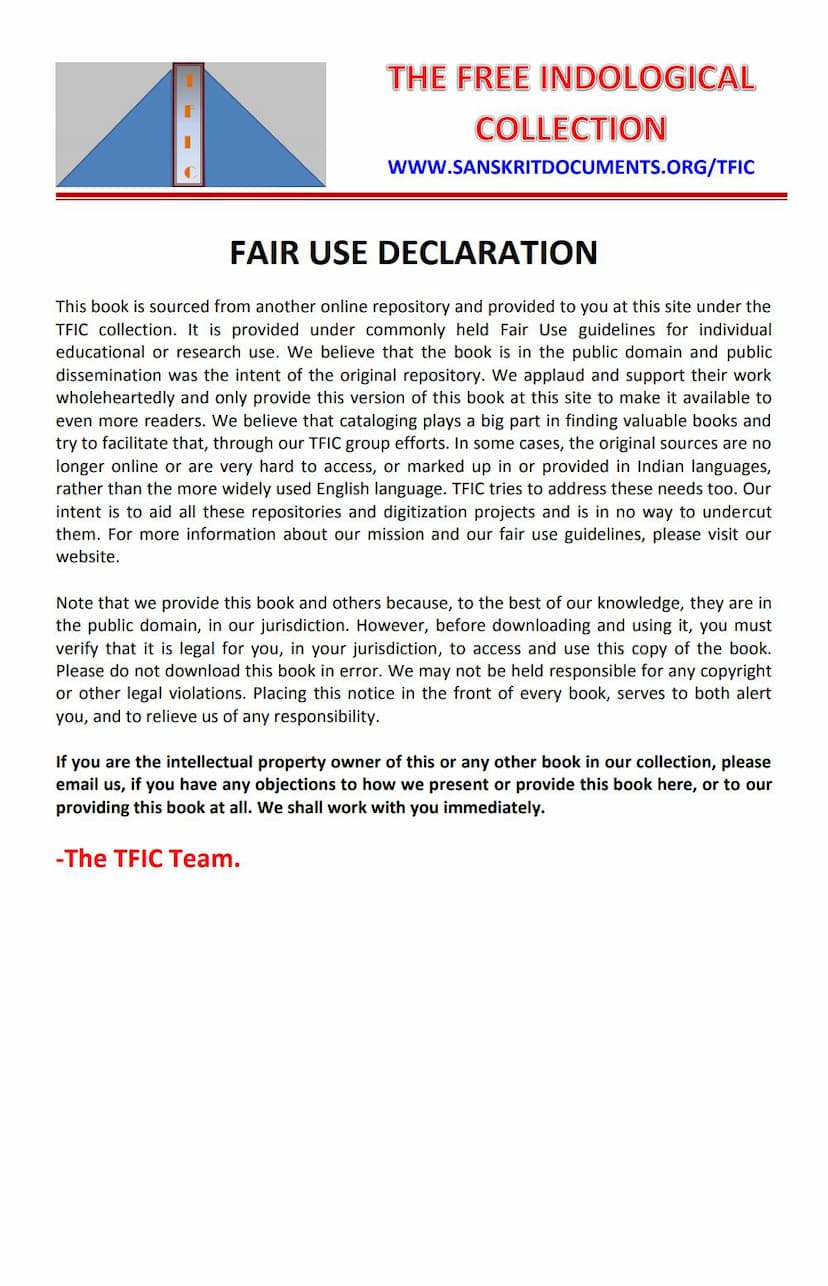Critical Introduction To Panhavagara
Added to library: September 1, 2025

Summary
This document is a dissertation submitted by Amulyachandra Sen to the Philosophical Faculty of the Hansische Universität in 1936. The dissertation is titled "A Critical Introduction to the Panhavagaranaim," which is identified as the tenth Anga of the Jaina Canon.
The work provides a comprehensive critical analysis of the Panhavagaranaim text. Here's a summary of its key aspects:
1. Genesis and Nature of the Text:
- Position in the Jaina Canon: The Panhavagaranaim is the tenth of the eleven Anga texts.
- Formal Character: The text is described as largely devoted to secular matters, a departure from its predecessor and successor Angas which are legendary.
- Title and Contents: The title "Panhavagaranaim" is traditionally interpreted as "Questions and Explanations." However, the extant version does not align with this title, as it contains very few direct questions and answers. This suggests that the original text known to earlier compilers of Jaina literature (like the compilers of Thana and Samavaya) was lost and replaced by a different text.
- Later Origin: Sen argues for the later origin of the current Panhavagaranaim, citing its metrical structure (predominance of Vedha, which is a later meter), its style, and its phraseological borrowings from and parallelisms with older texts like the Āyāranga and Sūyagaḍa. The presence of "sanscriticisms" and specific vocabulary also points to a later period.
2. Structure and Content:
- The work is broadly divided into two parts:
- Part I: The Gates of Sin (ahama-dāras): The first five chapters deal with the five cardinal sins: killing, falsehood, stealing, unchastity, and possession of property. Each chapter focuses on the nature, epithets, ways of commission, consequences, and perpetrators of these sins.
- Part II: The Gates of Prevention of Sin (samvara-dārāi): The last five chapters deal with the stoppage of sin, or samvara. These chapters primarily focus on ascetic life and practices.
- Specific Content of Chapters:
- First Five Chapters (Sins): These chapters detail the sins with extensive lists of deprecatory terms and descriptions of consequences, including vivid descriptions of hellish torments. Sen notes that the text, unlike earlier ones, does not emphasize final liberation through asceticism.
- Last Five Chapters (Prevention of Sin): These chapters primarily cover ascetic practices and rules of conduct (bhāvanās). Sen considers these chapters to be of less general interest due to their focus on ascetic details but highlights some secular content like lists of languages, musical instruments, feminine ornaments, eatables, and works of art.
3. Critiques and Dating:
- Influence of Other Texts: Sen meticulously analyzes the text's borrowings and parallelisms with other Jaina texts like Āyāranga, Sūyagaḍa, Dasaveyāliya, Paṇṇavaṇā, and Uvavāiyā (Uva). He notes that the Panhavagaranaim often "constructively borrows and develops upon and alters what it adopts."
- Metrical Analysis: A significant portion of the dissertation is dedicated to analyzing the metrical structure, particularly the "Vedha" meter. Sen argues that the prevalence of Vedha and its irregular forms indicate a period after the classical Vedha epoch, suggesting a later composition date.
- Language and Style: The language and grammatical style are described as comparatively late, with irregular gender usage and occasional slackness in grammatical rules.
- Dating: Based on the metrical structure, linguistic features, and borrowings, Sen places the Panhavagaranaim in a period "midway between the vedha and the gathā epochs," acknowledging its later origin but noting attempts to give it an ancient flavor.
4. Secular Material Highlighted:
Sen pays particular attention to the secular content, which is unusual for Anga texts. These include:
- Languages: A reference to twelve kinds of languages, including Prakrit, Sanskrit, Magadhi, Paisaci, Sauraseni, and Apabhramsa, each in prose and verse.
- Musical Instruments: A list of various instruments like drums, lutes, flutes, and cymbals.
- Feminine Ornaments: Descriptions of girdles, necklaces, anklets, and other adornments.
- Eatables: A list of food items including rice, lentils, flour, molasses, and dairy products.
- Works of Art: Similar to the Āyāranga, a list of crafts like wood-work, painting, stone-work, and ivory-work.
- Mythological References: Mentions of the Baladevas and Vasudevas, and references to wars from Indian epics (like those for Sita and Draupadi), suggesting an engagement with broader Indian cultural narratives.
5. Commentary and Critical Notes:
The dissertation includes extensive critical notes on the commentary of Abhayadeva and textual variants found in different manuscripts and editions. This demonstrates a rigorous scholarly approach to analyzing the text.
In essence, Amulyachandra Sen's work provides a detailed scholarly introduction to the Panhavagaranaim, establishing its place within the Jaina Canon, analyzing its structure and content, and crucially, dating it through a critical examination of its language, meter, and textual relationships with older canonical and secular works. The study highlights the text's unique focus on secular matters and its contribution to understanding the evolving nature of Jain literature.